

TelepresenceForHealthCare_Cisco. International Journal of Telerehabilitation. NeoRehab. Kobo - Search Results for eBooks and eMagazines. Shopping Cart Your Shopping Cart is empty There are currently no items in your Shopping Cart.

Continue shopping Get a $5 credit today! Exclusive offer for new customers Learn More Sort By: Bestsellers Search Results. AustJPhysiotherv55i1Russell.pdf. TeleRehab and Telehealth. Telerehabilitation Store and Forward Applications: A Review of Applications and Privacy Considerations in Physical and Occupational Therapy Practice.
RERC TR: Projects. Our Research & Development tasks build upon our previous research in telerehabilitation and are in four focus areas: Cognitive and Vocational Rehabilitation Prevention and Management of Secondary Conditions Communication Technology Assessment anTraining Capacity Building The first three areas all have the potential to benefit from TR services provided in the natural environment.

Activities in the fourth focus area, Capacity Building, are aimed at knowledge translation and technology transfer. Each of the focus areas is dependent on the infrastructure core. Infrastructure Core: Informatics Infrastructure for Supporting Telerehabilitation Services in Clinical and Natural Environments The core components of the infrastructure were developed through past research. Telerehabilitation. Two important areas of telerehabilitation research are (1) demonstrating equivalence of assessment and therapy to in-person assessment and therapy, and (2) building new data collection systems to digitize information that a therapist can use in practice.
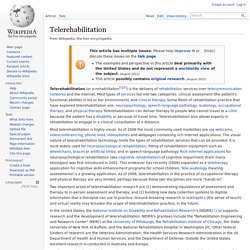
Ground-breaking research in telehaptics (the sense of touch) and virtual reality may broaden the scope of telerehabilitation practice, in the future. In the United States, the National Institute on Disability and Rehabilitation Research's (NIDRR) [1] supports research and the development of telerehabilitation. NIDRR's grantees include the "Rehabilitation Engineering and Research Center" (RERC) at the University of Pittsburgh, the Rehabilitation Institute of Chicago, the State University of New York at Buffalo, and the National Rehabilitation Hospital in Washington DC.
History[edit] In 1999, D.M. Three early adopters of telemedicine were state penitentiary systems, rural health care systems, and the radiology profession. IT REhab_IntegralTelrehabSystem_AALForum2012.pdf. Telerehabilitation: remote multimedia-supported assistance and mobile monitoring of balance training outcomes can facilitate the clinical staff's effort - ResearchGate. Smart2 publications — the smart consortium. Rosser BA & Eccleston C. (2011), "Smartphone applications for pain management", Journal of Telemedicine and Telecare, 17: 308-312.
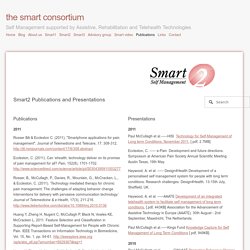
Eccleston, C. (2011). Can ‘ehealth; technology deliver on its promise of pain management for all? Pain, 152(8), 1701-1702. Rosser, B., McCullagh, P., Davies, R., Mountain, G., McCracken, L., & Eccleston, C. (2011). ‘Technology mediated therapy for chronic pain management: The challenges of adapting behavior change interventions for delivery with pervasive communication technology.’ Huang Y, Zheng H, Nugent C, McCullagh P, Black N, Vowles KE, McCracken L, 2011. Module 3: Telerehabilitation. The rehabilitation service delivery field is trying to transition toward a more outcomes-oriented process that seeks to maximize function and social re-integration, subject to constraints on resources (see Figure below).
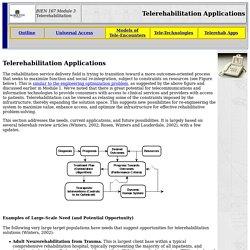
This is similar to the engineering optimization problem, as suggested by the above figure and discussed earlier in Module 1. We've noted that there is great potential for telecommunications and information technologies to provide consumers with access to clinical services and providers with access to patients. Telerehabilitation can be viewed as relaxing some of the constraints imposed by the infrastructure, thereby expanding the solution space. This suggests new possibilities for re-engineering the system to maximize value, enhance access, and optimize the infrastructure for effective rehabilitative problem-solving. This section addresses the needs, current applications, and future possibilities. Examples of Large-Scale Need (and Potential Opportunity) The Future? International Journal of Telerehabilitation. Telerehabilitation: current perspectives. Advocacy_Background_Papers_Telerehabilitation.pdf. Telerehabilitation.
Telerehabilitation. Telerehabilitation_blueprint. TELEREHABILITATION. Tell us about the community that you engage?
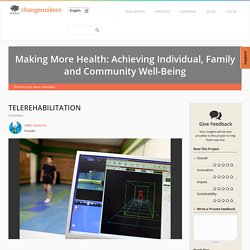
Eg. economic conditions, political structures, norms and values, demographic trends, history, and experience with engagement efforts. According to studies by CIREC in recent years and based on PAIMAC figures (Presidential Program for Comprehensive Action against Antipersonnel Mines) in almost 20 years the number of landmine victims MAP exceeds 9000 people. Of these, 42% were civilians and 58% remaining members of the security forces, 64% of total of victims survived the crash, while the remaining 36% died in the same way about the involvement of the civilian population, it should be noted that 18% were women and 30% were minors at the time of the accident. American-occupational-therapy-association.pdf. A Web based Plataform for a New Telerehabilitation Model under Community-Based in Rural Areas.
Asocaña. (2011).
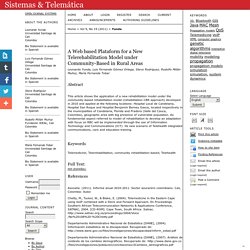
Informe anual 2010-2011. Sector azucarero colombiano. Cali, Colombia: Autor. Chetty, M., Tucker, W., & Blake, E. (2004). Telemedicine in the Eastern Cape using VoIP combined with a Store and Forward Approach. Departamento Administrativo Nacional de Estadística [DANE], (2004). Departamento Administrativo Nacional de Estadística [DANE], (2007). Telerehab_Opportunities_in_Occupational_Therapy. The use of telerehabilitation in assistive technology. Abstract Telerehabilitation is an evolving technology designed to assist rehabilitation practitioners and caregivers in delivering rehabilitative services to consumers at a remote site.

In its simplistic form, it is a way of providing patient information between rehabilitation practitioners who are physically separated from patient. It offers an ideal tool to promote this sharing of information and help in managing patients with chronic health diseases and persons with disabilities. Advocacy_Position_Telerehabilitation_2009.pdf. Speech-Language Pathology and Telerehabilitation. Speech-language pathology services are eminently suited to delivery via telerehabilitation owing to the audio–visual nature of the interaction between the clinician and the client.

Livrel6_div9.pdf. Telerehabilitation making progress via the Cloud. A Portable Robot for Tele-Rehabilitation: Remote Therapy and Outcome Evaluation - Download Statistics.